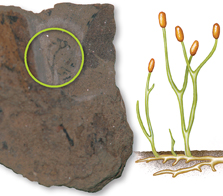The History and Evolution of Plants
 How did plants adapt to life on land?
How did plants adapt to life on land?
For most of Earth's history, land plants simply did not exist. Life was concentrated in oceans, lakes, and streams. Although photosynthetic prokaryotes added oxygen to our planet's atmosphere and provided food for animals and microorganisms, true plants had not yet appeared on the planet.

FIGURE 22–3 A Fossilized Plant One of the earliest fossil vascular plants was Cooksonia. This fossil shows the branched stalks that bore reproductive structures at their tips.
Origins in the Water The fossil record indicates that the ancestors of today's land plants were water-dwelling organisms similar to today's green algae. Most of these photosynthetic eukaryotes were unicellular, although a few were composed of multiple cells. At first, many biologists wondered if green algae should actually be included in a kingdom that includes organisms as large and complex as oak trees and orchids. But now it is clear that green algae have cell walls and photosynthetic pigments that are identical to those of plants. They also have reproductive cycles similar to those of plants. Finally, studies of their genomes suggest that they are so closely related to other plants that they should be considered part of the plant kingdom.
The First Land Plants Fossil spores of land plants occur in rocks 475 million years old, but the plants themselves from this time period left no fossils. The oldest fossils of land plants themselves are found roughly 50 million years later in the fossil record. Lacking leaves and roots, these plants were only a few centimeters tall. The greatest challenge that early land plants faced was obtaining water, which they achieved by growing close to the ground in damp locations. Fossils also suggest that the first true land plants were still dependent on water to complete their life cycles.  Over time, the demands of life on land favored the evolution of plants more resistant to the drying rays of the sun, more capable of conserving water, and more capable of reproducing without water.
Over time, the demands of life on land favored the evolution of plants more resistant to the drying rays of the sun, more capable of conserving water, and more capable of reproducing without water.
For more on the diversity of animals, go to the Visual Guide.  DOL•30–DOL•64
DOL•30–DOL•64

FIGURE 22–4 Major Groups of Plants There are five main groups of plants in existence today. Interpret Diagrams In the ancestor to which plant groups did seeds first evolve?
dTable of Contents
- Formulas and Equations
- Applying Formulas and Equations
- Mean, Median, and Mode
- Estimation
- Using Measurements in Calculations
- Effects of Measurement Errors
- Accuracy
- Precision
- Comparing Accuracy and Precision
- Significant Figures
- Calculating With Significant Figures
- Scientific Notation
- Calculating With Scientific Notation
- Dimensional Analysis
- Applying Dimensional Analysis




